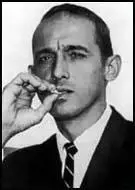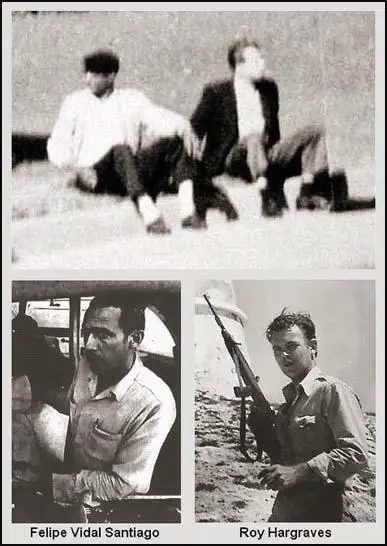Felipe Vidal Santiago

Felipe Vidal Santiago was born in Cuba. He became a Cuban naval officer but went into exile when Fidel Castro gained power in 1959. He lived in South America before moving to Miami where he associated with the Interpen (Intercontinental Penetration Force) group.
Vidal became a close friend of John Martino. He also worked closely with Roy Hargraves and carried out a series of raids on Cuba in the 1960s. This involved a plan to to create a war with Cuba by simulating an attack on Guantanamo Naval Base.
In December 1962, Vidal had a meeting with a lawyer connected to a "Citizen's Committee to Free Cuba". He told Vidal about a conversation he had with Henry Cabot Lodge, who had been told by Walt Rostow, that John F. Kennedy was exploring "a plan to open a dialogue with Cuba."
Vidal was furious about what he considered to be an act of betrayal and immediately told leaders of the anti-Castro community and his CIA contact, Colonel William Bishop. According to Dick Russell, Vidal was also "an information conduit for" General Edwin Walker.
Larry Hancock argues in his book, Someone Would Have Talked, that Vidal traveled to Dallas on several occasions between 31st October and 21st November 1963 in order to raise funds for the anti-Castro exiles. This included meeting Edwin Walker. On his return to Miami he "reportedly stated that Walker had no further interest in Cuban affairs." However, Gerry Hemming has claimed that Vidal obtained money from H. L. Hunt, who had been largely responsible for funding Walker's campaign for governor in Texas. Clint Murchison and Gordon McLendon have also been suggested as possible contributors to Vidal's operation.

Dick Russell later interviewed William Bishop who confirmed that he was aware of the plot to kill John F. Kennedy. He claimed the plot included people such as Tony Varona and Roland Masferrer. "By 1963, the Cuban element - see, Kennedy had gone to Miami, to the Orange Bowl down there, and made this statement that the brigade's flag would fly over Cuba and all this crap. That was a stopgap. The exiles for a time believed him. Then shortly after that, a presidential executive order came out that no military-style incursions into Cuba based from the United States would be tolerated. The end result was complete distrust and dislike for Kennedy and his administration by the Cuban exiles. You take Tony Varona and Rolando Masferrer to name but two - and there were many, many more - when serious talk began to happen about the possibility of assassinating Kennedy."
Some researchers have suggested that Vidal was involved in the assassination of John F. Kennedy. Others have claimed that he can be seen on the Grassy Knoll with Roy Hargraves.
Felipe Vidal Santiago was captured after entering Cuba. He was accused of being sent by Manuel Ray. Santiago was interrogated by Fabian Escalante. He later recalled: "He (Felipe Vidal Santiago) was arrested in March of 1964 when he tried to ram his boat in Cuba with three others to perform acts of sabotage. There he had many conversations with us... He was informing the groups of exiles in the United States about Kennedy administrations attempts to have dialog with Cuba. While interrogating Santiago in Cuba, we came up with some more interesting information. He was arrested in 1964, March. A few months after the assassination. He explained that he had a relationship with a CIA official, who was military intelligence - William Bishop. He says that in November of 1963, William Bishop invited him to a meeting in Dallas. It was a meeting with a few wealthy people in Dallas talking about financing an anti-Castro operation."
On 28th May, 1964, Miami Times reported: "Havana radio reported today that four agents of the U.S. Central Intelligence Agency were executed by a firing squad on Tuesday for trying to land on the north coast of Cuba. The broadcast charged they were agents sent to Cuba by Mandolo Ray, head of the anti-Castro Revolutionary junta, to infiltrate Las Villas Province and lead subversive activities. One of the executed men were identified as Major Felipe Vidal Santiago, a diplomatic aide in charge of the Cuban Embassy in Venezuela shortly after Castro took over in Cuba."
Primary Sources
(1) Fabian Escalante, Cuban Officials and JFK Historians Conference (7th December, 1995)
He (Felipe Vidal Santiago) was arrested in March of 1964 when he tried to ram his boat in Cuba with three others to perform acts of sabotage. There he had many conversations with us. He just told us this of his own accord. We didn't ask questions. Our interest really were in the plan of sabotage. Sabotage when and where. We wanted to know what was behind the sabotage and then he started to talk about his subject. So then, that's why a decision was made to take down everything he said. And that's why we have tapes. He talked about things not associated with the sabotage. There were too many people, we didn't have the resources or tapes to take it. It was in his first declaration, it was political information. He came to us for the first time to talk to us about September of 1962, opening a communication with Cuba. And that was very important to tape all of his conversations about Cuba.
He was informing the groups of exiles in the United States about Kennedy administrations attempts to have dialog with Cuba. While interrogating Santiago in Cuba, we came up with some more interesting information. He was arrested in 1964, March. A few months after the assassination. He explained that he had a relationship with a CIA official, who was military intelligence - William Bishop. He says that in November of 1963, William Bishop invited him to a meeting in Dallas. It was a meeting with a few wealthy people in Dallas talking about financing an anti-Castro operation.
In the first few days of November, 1963, he says that William Bishop picked him up in his car in Miami and they drove to Dallas. They were there for about four days. This would had to have happened the weekend before the assassination, according to what he says. They stayed in a second class hotel. They stayed in a second class hotel. Bishop left several times to have interviews. But this guy did not know who he was talking to. After approximately four days, they returned to Miami. After the assassination, they were in Tallahassee, when he went to visit a new house for a new car.
(2) Dick Russell, High Times Magazine (August 1996)
After the October 1962 Cuban Missile Crisis brought the USA and USSR to the brink of nuclear war, Kennedy's agreement with the Soviets officially barred further U.S. attempts to overthrow Castro or invade Cuba, and U.S.-Soviet relations began to thaw. Even though the CIA continued to plot Castro's assassination, the Kennedy Administration quietly began seeking a rapprochement with Cuba, says Escalante. But before long, wind of the President's efforts got to the CIA and its Miami-based Cuban-exile minions.
Exile militant Felipe Vidal Santiago, arrested on a 1964 sabotage mission into Cuba, told his captors that in Washington, D.C. in December 1962 he'd met with a lawyer/lobbyist connected to a "Citizen's Committee to Free Cuba." This lawyer informed Vidal Santiago of a conversation he'd had with Republican Henry Cabot Lodge, soon to be U.S. ambassador to South Vietnam, who said he'd heard from Kennedy aide Walt Rostow of "a plan to open a dialogue with Cuba."
"Vidal told us he was very surprised," says Escalante. In fact Vidal, infuriated and betrayed, had alerted his exile cohorts, as well as a CIA contact, Colonel William Bishop. "It was almost like a bomb, an intentional message against Kennedy." Vidal was also an information conduit for General Edwin Walker, the ultra-right Texan paramilitary leader at whom Oswald had allegedly taken a shot in April 1963. And FBI files call Vidal a "very close friend" of Miami mobster John Martino, who intimated to family and associates that he had foreknowledge of the JFK assassination...
Felipe Vidal Santiago told Cuban intelligence that on the weekend before the assassination, he was invited to a meeting in Dallas by the CIA's Colonel William Bishop. "It was supposed to be a meeting with a few wealthy people to talk about financing anti-Castro operations," says Escalante. Bishop left on his own "for interviews" numerous times during their stay in Dallas. After approximately four days they returned to Miami.
Not long before his death in 1993, Colonel Bishop confirmed to this writer that he'd had knowledge of the JFK plot. The Cubans indicate that the Vidal-Bishop Dallas trip concerned plans for re-taking the island once Castro's people had been implicated in the assassination.
Escalante surmises: "Oswald was an intelligence agent of the U.S.-CIA, FBI, military, or all of these, we don't know. He was manipulated, told he was penetrating a group of Cuban agents that wanted to kill Kennedy. But from the very beginning, he was to be the element to blame Cuba."
"Not less than 15 persons took part in the assassination," Escalante theorizes. "At the same time, knowing a little about CIA operations, we see how they used the principle of decentralized operations-independent parties with a specific role, to guarantee compartmentalization and to keep it simple."
The Nassau gathering marked the inception of what is anticipated will be an ongoing exchange between Cuban and U.S. researchers into the assassination. The hope is that access to Cuban documentation might be provided in the future-such as Tony Cuesta's written "declaration." The fact that former Cuban intelligence officials are willing to share their knowledge signifies a momentous watershed in the ongoing effort to unravel the haunting mystery of who really killed JFK.
(3) Larry Hancock, Someone Would Have Talked (2007)
In addition to his involvement in the Bayo-Pawley mission, John Martino was personally involved with Felipe Vidal Santiago, Frank Fiorini/Sturgis, and others within the Miami exile community including individuals who had been part of the "casino" scene in Havana.
Vidal mentioned several visits to General Walker during 1963. Walker himself had limited personal funds and relied on his connections to right-wing organizations and in particular, to H.L. Hunt who was largely responsible for funding Walker's campaign for governor in Texas. There is no documented account of Vidal meeting with Hunt or Hunt's representatives. However, Hunt's behavior after the assassination suggests that he may have been concerned about somehow being implicated, at least by his associations or remarks.
Gerry Hemming places Hunt, Murchison and Gordon McLendon, a close friend of David Phillips and supporter of Phillips' intelligence agent organization at a Petroleum Club meeting in Dallas where Texans introduced the subject of eliminating John Kennedy along with Fidel Castro. Hemming also stated that Vidal dealt with the Hunts but that they maintained an arms length relationship and did not want to know any details of Vidal's activities."
(4) Miller Davies, Miami Times (28th May, 1964)
IHavana radio reported today that four agents of the U.S. Central Intelligence Agency were executed by a firing squad on Tuesday for trying to land on the north coast of Cuba.
The broadcast charged they were agents sent to Cuba by Mandolo Ray, head of the anti-Castro Revolutionary junta, to infiltrate Las Villas Province and lead subversive activities.
One of the executed men were identified as Major Felipe Vidal Santiago, a diplomatic aide in charge of the Cuban Embassy in Venezuela shortly after Castro took over in Cuba...
The broadcast said the three other men executed were Ladislao Gonzales Benitez, Elias Rivero Bello and Alfredo Valdes Linares.

